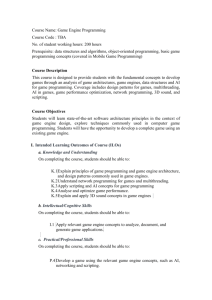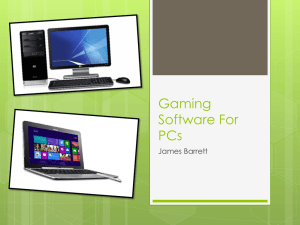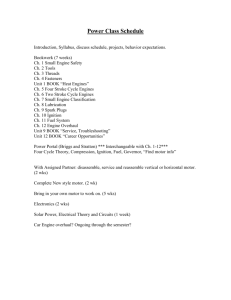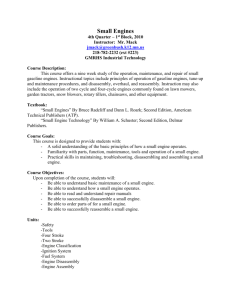Game Engines
advertisement
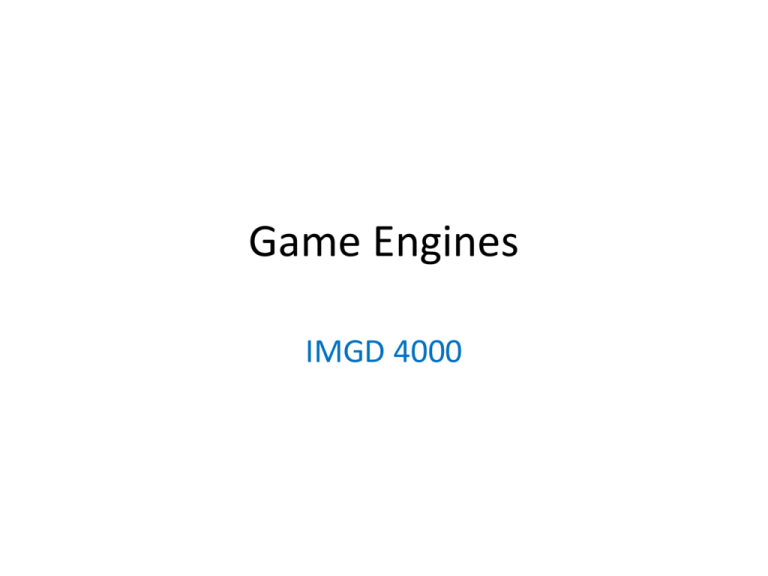
Game Engines IMGD 4000 Pedagogical Goal • Your technical skills should not be tied to any particular game engine • Just like your programming skills should not be tied to any particular programming language • Use best tools for each job • ... or tools you were given 2 Game Engine Definition Game Engine “A series of modules and interfaces that allows a development team to focus on product gameplay content, rather than technical content.” [Julian Gold, O-O Game Dev.] • But this class is about “the technical content”! 3 Buy versus Build • Depends on your needs, resources and constraints – Technical needs (e.g., “pushing the envelope”?) – Financial resources (e.g., venture capital?) – Time constraints (e.g., 1 month or 2 years?) – Platform constraints (e.g., Flash?) – Other factors (e.g., sequel?) • Most games commonly built today with some sort of “engine layer” 4 Why Build? • Technical needs of game not supported by exisiting engines • Pedagogy (to learn) • Provide a better understanding of engine-game interaction when making game – Can extend/adjust engine if needed • Have engine especially fit genre (lightweight, just features required) • Don’t want to pay out royalty fees – Note, cost is not a reason – there are many excellent cheap/free engines it will “cost” more to build an engine! Why Buy? • Financial – don’t have the time/money to build and engine • Support – existing engine has large user community and/or documentation • Robust – existing engine has fewer bugs, tried and true code base • Experience – development team has prior experience with engine Choices: “It’s a Jungle Out There” • 372 3D engines reviewed at DevMaster.net • IndieDB shows 407 engines, rates top 10 • We are not going to try to review them all here 7 [ DevMaster.net ] Many Evaluation Dimensions/Features If there’s a feature term here you don’t know, you should look it up! 8 Evaluation by Size – Lines of Code “Measuring software productivity by lines of code is like measuring progress on an airplane by how much it weighs.” - Bill Gates Dragonfly (2014) 4k id Tech 1 (1999) id Tech 2 (2001) id Tech 3 (2005) id Tech 4 (2011) 79k 138k 329k 586k UE4 v4.6 (2015) 1964k • • Used cloc Only counting C, C++ and header files. Game Engine Architecture Saucer: hit() Hero: kbd() GAME CODE Star: onEvent() TextMessage: step() DrawCharacter InsertObject LoadSprite DRAGONFLY GetKey MoveObject SendEvent Allocate memory Clear display COMPUTER PLATFORM File open/close Get keystroke What are architecture choices for Game Engine layer? 10 Types of Engine Architectures (Broadly) • Monolithic (e.g., GameMaker) • Modular – Extensible IDE (e.g., Unity, UE4) – Open Class Library (e.g., C4, UE4, or what Dragonfly would be when it grows up ) 11 Monolithic Engines • “Old style”- typically grew out of specific game – e.g., ID Tech for first-person shooters • Tend to be genre-specific – e.g., GameMaker for arcade-style games • Difficult to go beyond extensions/modifications not anticipated in API (e.g., scripting) • Proven, comprehensive capabilities – Good for original purpose 12 Modular Engines • “Modern” - often developed by game engine company (relatively new category) – e.g., Unity • Use object-oriented techniques for greater modularity • Much easier to extend/replace components than for monolithic engines 13 Modular: Extensible IDE’s • GUI-oriented development process – More accessible for novice/casual programmers – More “art asset friendly” • Comprehensive asset management – Integrated with IDE • Limited (or controlled) exposure of internals – Prevents abuse – Prevents some extensions 14 Modular: Open Class Library • Code-oriented development • Carefully layered • Allows maximum modifiability • Often open source – UE4 source available, but not freely distributable • Not as accessible for novices and “casual” programmers 15 Game Engine Architecture Blocks 16 Game Engine Architecture Blocks ai gui animation input camera level builder controllers modeler effects physics game logic renderer geometry scene graph graphics operating system Where to place each components? sound Game Engine Architecture Blocks (complete?) Game Engine Architecture, by Jason Gregory, 2009, AK Peters, ISBN: 1-5688-1413-5. 19 Game Engine Architecture Blocks Best Engine Choice is Relative to Situation • Similar issues of needs, resources and constraints (as in buy vs. build) – – – – – Platform, programming language constraints Cost constraints (commercial run $ to $$$) Specific technical features required (e.g., MMO) Previous experience of staff Support from developers, user community (e.g., forums) – Pedagogical goals (e.g., this course, or even to teach yourself) 20 Choice of UE4 for IMGD 4000 • Relatively easy (trivial) for artists – C4 tough, Dragonfly limited – Comparable to Unity? • Programming in C++ – Still “gold standard” for tech game development – Need for IMGD majors to do more, get better • Full support of mature IDE – Microsoft Visual Studio (Windows), Xcode (Mac) • Source code available – Aid in debugging interactions – Future offerings may delve into code 21 UE4 in Timeline of FPS Game Engines (Click below to open browser to image for zooming) http://commons.wikimedia.org/wiki/File:Fpsengine.svg 22 Feature Comparisons vs vs • C4 & Unity from DevMaster.net • UE4 from UE4 Features and other UE4 docs • Caveats: – Not complete - broad view of main features touched upon in IMGD 4000 – Info is not audited (e.g., DevMaster.net from enthusiasts, UE4 from my knowledge and Epic docs) – Let’s not get bogged down in the details – the idea is to get overall sense of emphasis 23 General Features Object-Oriented Design, Plug-in Architecture, Save/Load System • Clean class hierarchy for scene graph nodes • General state serialization support for saving worlds • Separation between per-instance and shared data • External scene graph referencing from within another scene graph • Support for pack files and virtual directory hierarchy • Skinable GUI's Object-Oriented Design, Plug-in Architecture, Save/Load System • Professional FPS controller ready to drop in (and tune) • Streamed loading for the Unity Web Player • Unity asset server / asset source code version control • Cross-platform Web player • Standalone executables for both Mac OS X and Windows • Mac OS X Dashboard Widgets • iPhone Publishing is available as add-on product • Streaming Asset Bundles: the ability to stream in any asset (terrain, mesh, etc) into the game Object-Oriented Design, Plug-in Architecture, Save/Load System • Professional FPS controller ready to drop in (and tune) • Multiplatform compilation – Windows, Mac, Linux Mobile • Built-in content and community integration 24 Physics Basic Physics, Collision Detection, Rigid Body • Built-in character controller • Built-in projectile controller • Real-time fluid surface simulation • Real-time cloth simulation Basic Physics, Collision Detection, Rigid Body, Vehicle Physics • Powered by the PhysX Engine, which also supports particle physics • Cloth simulation Basic Physics, Collision Detection, Rigid Body, Vehicle Physics • Powered by the PhysX Engine, which also supports particle physics 25 Scripting • Graphical script editor • Scripts are edited graphically for easy artist/designer access • Games can easily define custom script components, and these automatically appear in the editor • Controllers can advertise custom function calls that can be accessed from scripts • Scripts support variables, looping, and conditional execution, all shown in a concise graphical manner • Uses the Mono and supports JavaScript, C# and Boo, interoperable (to a certain extent) and JIT'ted to native code • Complete scripting documentation • Source-level debugging • Blueprints visual scripting, easier “programming” for artists and designers • Live debugging of script code before trying out in game • Extensible scripting Objects can link with blueprints to be used in script code 26 Builtin-Editors • Full-featured integrated cross-platform world editor • Interface panel editor • Complete built-in windowing system • Powerful and intuitive interface design • Advanced surface attribute manipulation and material management • Editor provides asset pipeline: save a file and it updates automatically • Editor Extensibility: Create custom editor windows, and new tools and workflows • Asset Server that provides version control capabilities for Unity projects • Optimized for use with large projects • Updates, commits, and graphical version comparisons inside the Unity editor. • World editor • Version control integration – indicates objects that are checked in, out. Can do diffs, etc. within editor 27 Graphics Lighting: Per-vertex, Per-pixel, Lightmapping, Radiosity, Gloss maps, Anisotropic: Texturing: Basic, Multi-texturing, Bumpmapping, Mipmapping, Projected Shaders: Vertex, Pixel, High Level: Shadows: Shadow Mapping, Projected planar, Shadow Volume … Lighting: Per-vertex, Per-pixel, Lightmapping Texturing: Basic, Bumpmapping, Procedural Shaders: Vertex, Pixel, High Level Shadows: Projected planar … Lighting: Lightmapping, Per-pixel, Texturing: Basic, Bumpmapping Shaders: Shadows: … 28 Networking Client-Server: • Fast, reliable network implementation using UDP/IP • Solid fault tolerance and hacker resistance • Advanced security measures, including packet encryption • Automatic message distribution to entity controllers • Cross-platform internet voice chat Client-Server: • Build on Raknet • Supports .NET library and asynchronous WWW API • Multiplayer networking (advanced NAT punch-through, delta compression, easy to set up) (cf. guest lectures later in term) Client-Server: • • • • Communication via RPC Reliable and unreliable Built in voice support Network simulation features (e.g., packet lag, packet loss) 29 AI AI system: • • • Behavior trees Real-time navmesh (pathfinding) Environment query tree


